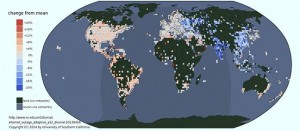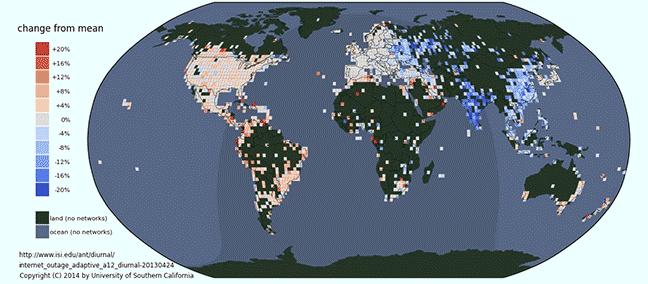
The wealthier a country is, the more likely the Internet will be up and running at all times. In other parts, it “sleeps”, almost like a living creature, researchers studying how big the Internet is, have concluded.
While the Internet is always up and running for some—such as those with broadband access in the US and Europe—in other areas, people’s access to the Internet varies over the course of the day, notably in Asia, South America, and Eastern Europe.
The finding, according to a press release by the University of Southern California (USC), will help scientists and policymakers develop better systems to measure and track Internet outages, such as those that struck the New York area after Hurricane Sandy. Understanding how the Internet sleeps will help them avoid confusing a sleeping Internet with an Internet outage, a 21 October statement said.
“The Internet is important in our lives and businesses, from streaming movies to buying online. Measuring network outages is a first step to improving Internet reliability,” said John Heidemann, research professor at the USC Viterbi School of Engineering’s Information Sciences Institute (ISI), and the study’s corresponding author, in a statement on 20 October.
Heidemann collaborated with USC’s Lin Quan and Yuri Pradkin on the study, which will be presented at the 2014 ACM Internet Measurements Conference on 5 November.
Their study also correlates countries with strong diurnal (a pattern that recurs daily) Internet access with lower GDP. This means that the richer a country is, the more likely it is that the Internet will be up and running 24/7.
“This work is one of the first to explore how networking policies affect how the network is used,” Heidemann said.
Access to the Internet is crucial to bridge the digital divide, which is widening instead of narrowing down.
On average, the Internet contributes 3.4% to GDP, according to a May 2011 McKinsey study.
A 2 October (2014) study by consulting firm McKinsey and Co. pointed out that despite a booming online population, the gains will still leave up to 4.2 billion people offline. The report defined an offline population as those who have not used the Internet (from any device) in the past 12 months.
The worldwide Internet user population was around 2.7 billion in 2013, with 1.8 billion of them joining since 2004. The growth was fuelled by the expansion of mobile network coverage and increasing mobile Internet adoption, urbanization, shrinking device and data plan prices, a growing middle class, and the increasing utility of the Internet.
At the current pace, an additional 500-900 million people are forecast to join the online population by 2017.
Yet, these gains will still leave up to 4.2 billion people offline, said a 2 October report titled ‘Offline and falling behind: Barriers to Internet adoption’ by McKinsey and Co.
Due to the Internet’s potential to improve the lives of individuals, drive business growth and accelerate the economic development of countries, its absence has profound implications for the billions who are still offline as well as for the broader world community.
India, for instance, has about 243 million Internet users but just about 20% penetration.
According to the ‘Second Quarter, 2014 State of the Internet Report’, released by Akamai Technologies Inc on 1 October, the global average connection speed increased 21% from the first to second quarter of the year. At 4.6 Mbps, the global average connection speed exceeded the 4 Mbps broadband threshold for the first time.
The report noted that eight of the top 10 countries/regions saw double-digit percentage increases from the first to the second quarter of 2014, though South Korea kept its first place average connection speed (24.6 Mbps) with only a 4% quarterly increase.
Impressive 18% quarterly growth for Hong Kong (15.7 Mbps) pushed it ahead of Japan, which now matches Switzerland with an average connection speed of 14.9 Mbps.
India, with a little over 65 million broadband connections, has an average connection speed of 2 Mbps, which that of China is 3.7 Mbps.
